Menu
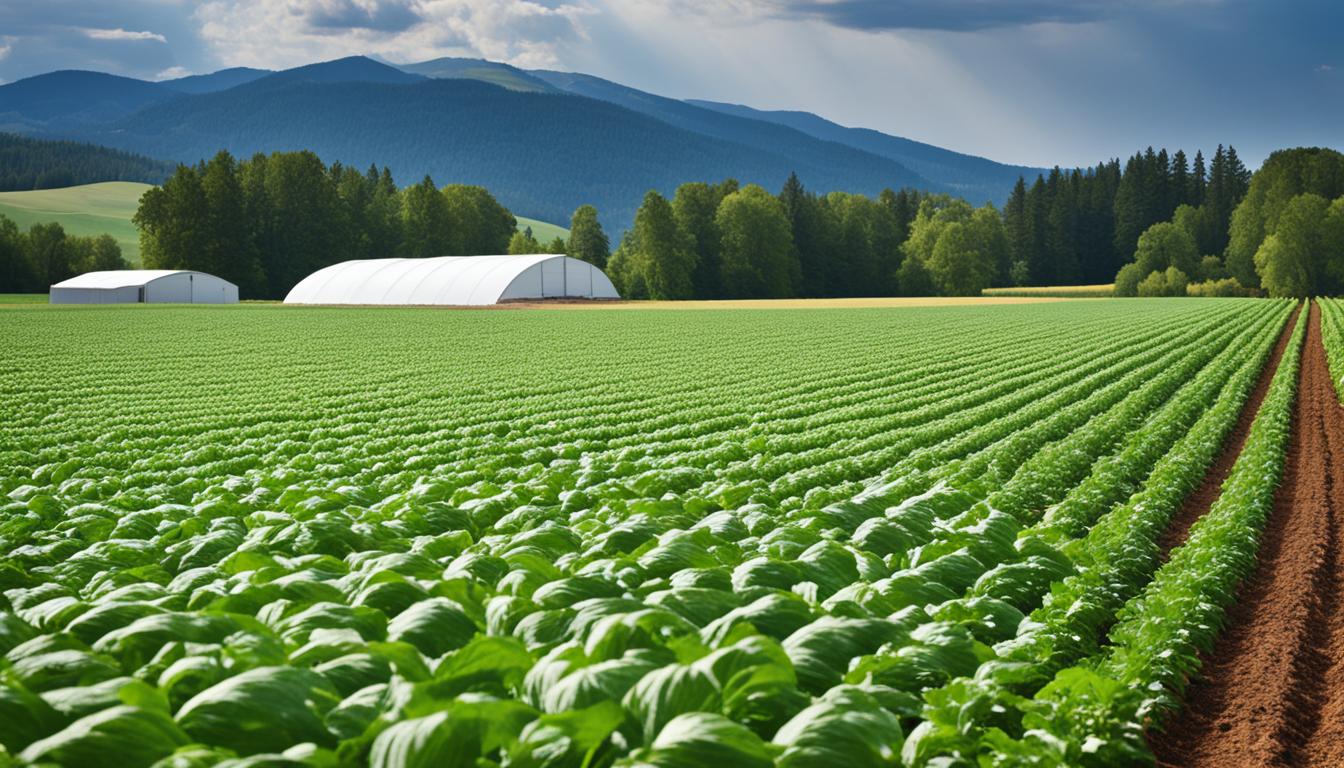
By 2050, we might need to produce 60-100% more food to meet demand. This shows how crucial it is to make summer crops more resilient. As the climate changes, farming needs to adapt for long-term sustainability and to secure our food.
China is a good example, making 260 million tons of maize yearly. This is 23% of the world’s supply. They show us how adaptable farming can help face these challenges.
The effects of climate change are being felt, particularly in crop growth. For example, maize yields change a lot based on the local climate. They might decrease in the southwest but increase in the northwest of China. To deal with this, we need smart farming strategies tailored to each region’s weather. This can help our crops grow better against the odds.
The future of farming depends on new adaptive methods. These should mix dealing with climate change with creative farming. We must understand how climate change affects each place differently. This way, we can protect our food sources for the future with smart summer crop strategies.
Crop biodiversity is key in today’s ever-changing world. It helps farmers fight climate change, pests, and diseases. By having many different crops, farmers increase their chances of success. This is because different types of crops can survive different problems.
Crop wild relatives give us a rich source of resilience for our food. Organisations like The Crop Trust and Embrapa work to find wild potato genes. These genes help crops grow even when facing drought, heat, and diseases.
Having many different versions of crop plants is important. It helps nature do its job, like pollination and controlling pests. By using things like cover crops and pest management, we make farms richer in plant and animal life. This helps the soil, keeps pests at bay, and makes our food grow better.
Having many different kinds of crops is good for people, the economy, and culture. Agricultural diversity means better food, healthier soil, and more pollinators. It also attracts bird species and helps protect against the weather. This way, we make sure there’s enough food and keep wildlife strong.
Creating farms with lots of different crops is crucial. It helps with crop growth, keeps jobs safe, and makes us able to handle the changing climate. By caring about the variety of crops and genes, we can overcome nature’s tests. We make sure there’s enough food for everyone.
Climate perturbations now play a big role in the problems faced by farmers. They change weather patterns and hurt crop growth. It’s vital to see the big picture of these changes and how they affect everyone, locally and globally.
Climate perturbations mean there’s a change from usual climate patterns. This can be because of more greenhouse gases. We see this as heatwaves, heavy rain, and droughts which hit farming hard. It’s key to predict these changes and find ways to cope.
Climate changes hit crop yields hard and quickly. For example, maize doesn’t like sudden weather changes. The use of drought-tolerant corn aimed to fight against dry conditions. But, unpredictable weather is still a big worry.
Regions like southwest and northwest China can see big shifts in crop growth due to changing rain patterns. Resilient crops are becoming more necessary in these places.
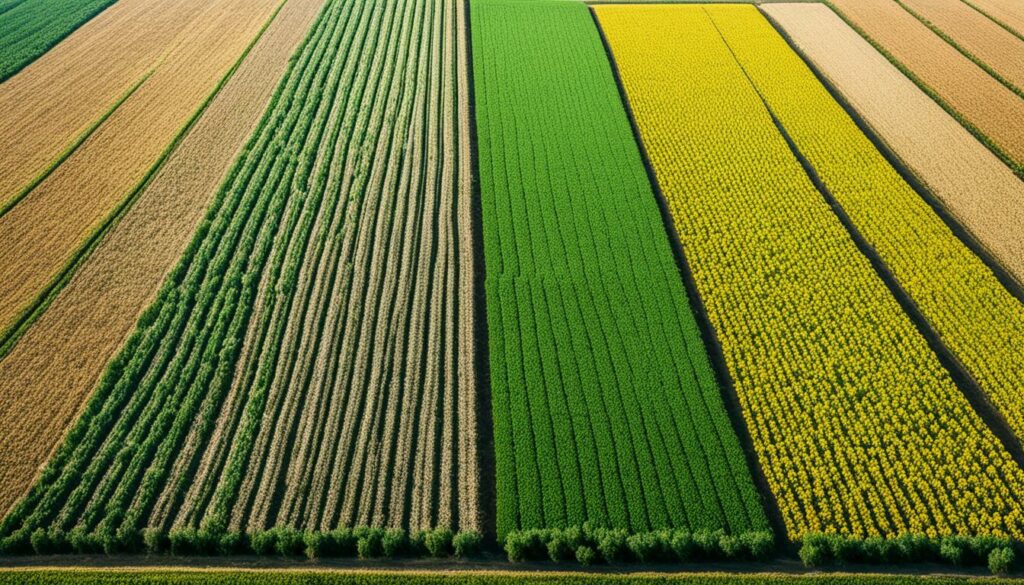
The effects of climate changes are deep and have many sides. Locally, we see harm to ecosystems and crops from high temperatures and more bugs. This hurts local life and farming.
Globally, climate changes mess up weather and cause more extreme events. This affects crops around the world. It’s essential for all nations to work together to handle these changes well.
To further contextualise these effects, below is a table summarising some key data points:
| Climate Impact | Example | Data Point |
|---|---|---|
| Rising Greenhouse Gases | Global Concentrations | CO2: 410 ppm, CH4: 1866 ppb, N2O: 332 ppb (as of 2019) |
| Extreme Weather Events | US Wildfires | 8 million acres burned in 2011, $1.9 billion in damages |
| Temperature Increases | Global Mean Surface Temperature | 1.09°C increase (2011-2020 compared to 1850-1900) |
Understanding climate perturbations deeply is crucial for tackling agricultural challenges.
The world urgently needs to make crops more able to deal with climate change. So, pre-breeding has become very important in farming studies. This step looks for good traits to help crops survive different climate problems.
First, we pick out useful traits from the wild cousins of crops. The Crop Wild Relatives project is a big part of this. It has found 3,200 wild cousins of 29 important crops. And amazingly, 85% of them are safe in the Millennium Seed Bank at Kew. This huge genetic collection gives us a lot to work with. It helps make crops more resilient. Also, farmers in 80 countries are trying out these traits in crops like alfalfa. This shows the traits are useful in the real world.
Next, we start mixing the good traits into crops. The Crop Trust project, supported by Norway, focuses on this. It puts good traits from wild and rare crops into the breeding work. For example, in eggplants, it is widening the variety of genes. This helps the plants cope better with climate change. They look for important traits like surviving drought and heat. These are then added to the breeding work. This makes the crops stronger to face the future.
However, pre-breeding also faces its own set of issues. Picking the right traits is hard work. Scientists are often dealing with tricky problems, for example, making eggplants fight off disease and handle heat better. Although steps have been taken for drought survival, real improvements in yield under dry conditions are rare. So, we still need a lot of work and people working together to make these crop improvements happen.
But, by tackling these challenges, we can improve crops a lot. They will be more able to withstand tough climates and ensure food for the future.
The urgent need for drought-tolerant crops is growing with climate change. Field trials in places like Brazil and India are teaching us a lot. These trials are showing how well these plants can survive and thrive in dry conditions.
In the trials, mixing alsike clover with black medic really stood out. This combination did better than growing them alone. These plants were tough, even when water was scarce, and showed good growth.

A special mention goes to alsike clover for its drought-tolerance. It could last up to 72 days after planting without much water. The alsike clover – black medic mix was resilient too, but not as much as alsike clover on its own.
| Crop Type | Non-stressed Productivity | Drought-stressed Productivity | Resilience (DAS) |
|---|---|---|---|
| Alsike Clover (AC) | High | Moderate | 44 to 72 |
| Black Medic (BM) | Moderate | Lower | 44 to 72 |
| Mixture (AC & BM) | Higher than sole crops | Moderate | 72 |
Brazil is using its varied climate to test drought-tolerant crops like alsike clover and black medic. In India, severe droughts are harming agriculture, reducing wheat and causing export bans. This shows why we need to grow crops that can withstand dry spells.
Drought-tolerant crops can reduce the impact of climate change on farming. Researchers are making crops like corn more resistant to drought through science. Drought-resistant corn already makes up a big part of US crops.
Using these strong plants can help ensure food for everyone. They help farmers deal with bad weather, keeping food on our tables.
Smallholder farmers are key in developing crops. They take part in activities like participatory breeding. This helps ensure new crop types are effective and sustainable in real-life conditions.
The Crop Wild Relatives project relies on these farmers’ knowledge in places like China and Kazakhstan. They help test vital crops like alfalfa that can cope with changing weather patterns.
One success story of this approach is the making of Drought-Tolerant (DT) corn in the U.S. This corn, developed between 2011 and 2013, took years of collaboration. Now, crops like GM wheat and rice are crucial for efficient farming.
As climate change intensifies, so do the challenges for farmers. They face saltier water, soil, and shorter frost-free periods. By working directly with these farmers, new crop types can be made to fight climate change’s effects. This keeps food growing stably in nations relying on farming.
Technology and tough crops are key in confronting climate change. Involving farmers helps make crops more robust and eco-friendly. It sets the stage for a stronger food supply for everyone in the future.
Having smallholder farmers actively involved is key to creating farming that can bounce back from challenges. They know the land and its needs better than anyone. This knowledge is vital for making farming resilient to changes in the weather. Working with experts helps them use this knowledge to come up with new ways to farm well, no matter the weather.
Testing crops locally is crucial to see which ones do best where. In Rio Grande do Sul, Brazil, for example, farmers have found that growing different crops at different times can make the land work better. It also helps reduce the risks that come with bad weather.
Working closely with researchers is vital for running farms that can face challenges. Companies like Thapasu and Konkuwan Herbs join forces with local farmers to keep food production steady. This way of working is also seen with Kimalaya Naturals and GrandMaa Millets, who team up with local people to farm in ways that protect the environment.
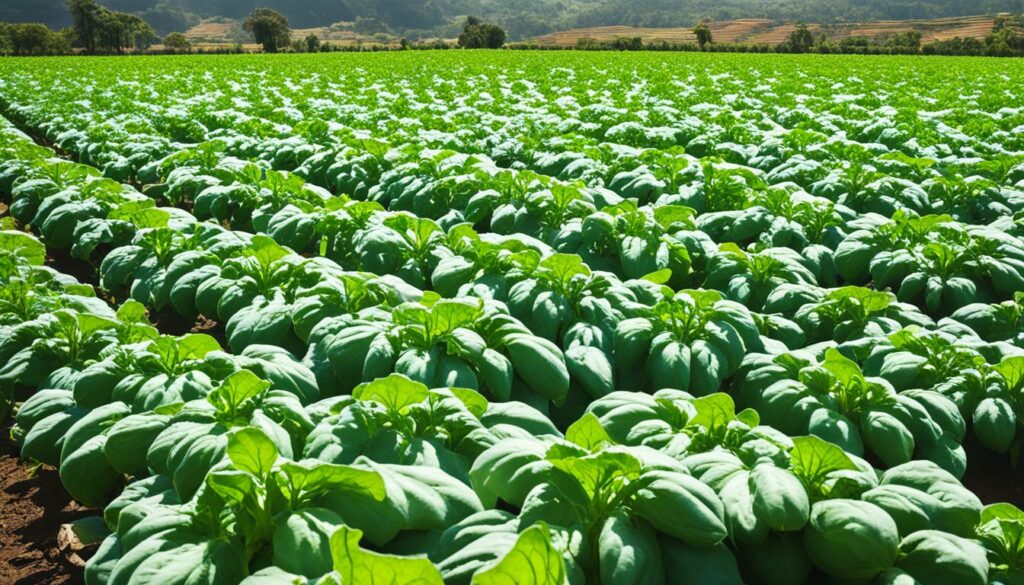
Farmers in Taiwan, especially eggplant farmers like Zhang Wen-jun, have shown the power of teaming up with experts. They have learned a lot by testing new kinds of eggplants to see how they cope with bad weather. This information is gold for breeding stronger crops and adjusting their farming methods to deal with new weather challenges.
| Crop Type | Production Loss (%) |
|---|---|
| Soybean (Specialised) | 17.5% |
| Beef (Livestock) | 2.6% – 8.6% |
Soil properties are key to making crops strong against tough conditions. Things like soil’s organic carbon, how it feels, how it keeps water, and dealing with temperature all matter. If we get these right, the farm can do well even when the weather is bad.
Soil’s organic carbon is vital for soil health and making crops strong. When there’s more organic carbon, plants get more food to grow well. This extra food can help crops survive odd weather better.
The kind of ground affects how much water it can hold. This is crucial for crops when there’s little rain. Changing the soil and how it holds water can make crop production more stable in tough times.
Right soil care can protect crops from too much heat. Adding more organic material in the soil can help. It means crops don’t suffer as much from wild weather changes. This is super important with climate change making temperatures jump up and down.
| Soil Property | Impact on Crop Resilience |
|---|---|
| Soil Organic Carbon | Enhances nutrient availability and moderates weather impacts |
| Soil Texture | Affects water retention and drought resilience |
| Water Retention | Stabilises yield under dry conditions |
| Temperature Mitigation | Buffers crops against extreme temperature changes |
Using innovative agricultural practices is more crucial as climate risks increase. These methods are essential for sustainable farming. They help maintain yields despite unpredictable weather.
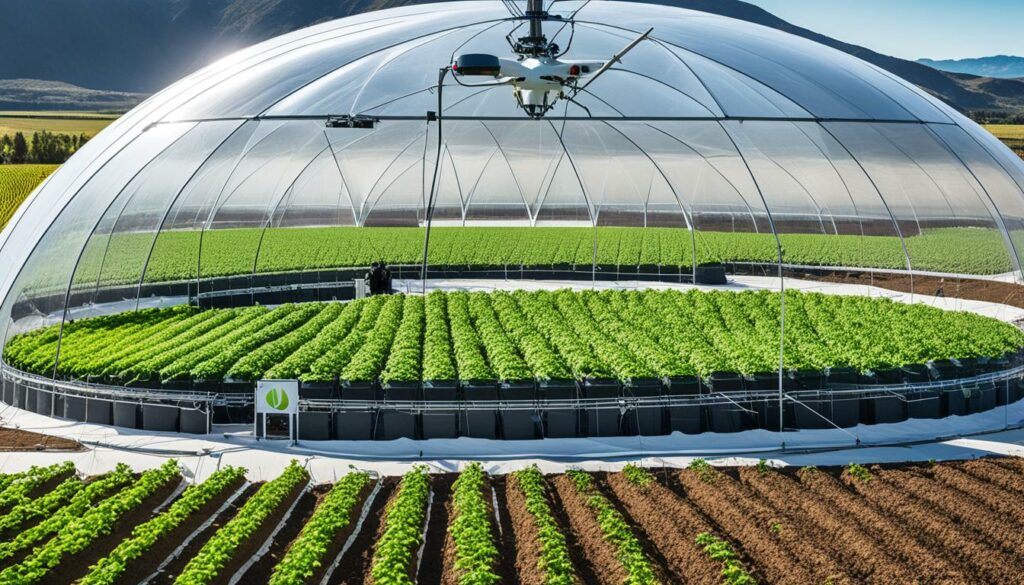
For climate adaptation, we rely on controlled irrigation systems. Techniques like drip irrigation save water well. They prevent water waste and ensure crops get just the right amount of water.
Growing drought-resistant crops is a key practice. These crops withstand dry periods, keeping agriculture stable. Breeding these tough plant varieties is vital in preventing crop losses from lack of water.
Using recycled water tackles the world’s water shortage problem. The practice saves fresh water and benefits the environment by reusing wastewater. It fits perfectly with sustainable farming and helps in long-term climate adaptation.
Adopting these new farming methods improves productivity while conserving the environment. Strategies like controlled irrigation and using recycled water make farming more resilient. They help agriculture deal with climate changes better, ensuring stability.
Global agricultural challenges need everyone to work together. The changing climate affects crops all over the world. Working as a team is key to finding strong solutions.
Research centres and think tanks are essential for understanding global issues. Groups like the Crop Trust and Millennium Seed Bank work with others. Together, they help improve food security and adjust to environmental changes.
Projects like the Crop Wild Relatives show how important working across countries is. Bringing experts from different places boosts our knowledge of crops. This means we can find solutions that work in many different environments.
Getting enough agricultural funding is vital for research centres. With proper resources, we can keep making crops stronger. This is essential as climate change’s effects grow.
Working together is key. Governments, NGOs, and businesses must join forces. They can help make farming more sustainable and efficient.
Consider the following data:
| Region | Affected Crop | Yield Reduction | Risk Level |
|---|---|---|---|
| India | Wheat | 15% | High |
| EU | Maize | 16% | Moderate |
| Italy | Olive Oil | 30% | Severe |
| US | Cotton | 40% | Extreme |
| Argentina | Maize | 95% | Moderate to Extreme |
With more heatwaves and changing weather, it’s vital to make summer crops tough. This means handling heat well and managing moisture. Using smart farming methods is key to make the most of growing conditions.
Rising temperatures from global warming are making it hard for crops to grow. To beat this, choosing crops that can handle the heat is a good idea. Shading and mulching can stop too much sun hitting the plants and keep the root area cool. Sunscreens like BRANDT Crop White SC reflect heat, keeping plants safe. Biostimulants help crops fight heat better by boosting their natural defences.
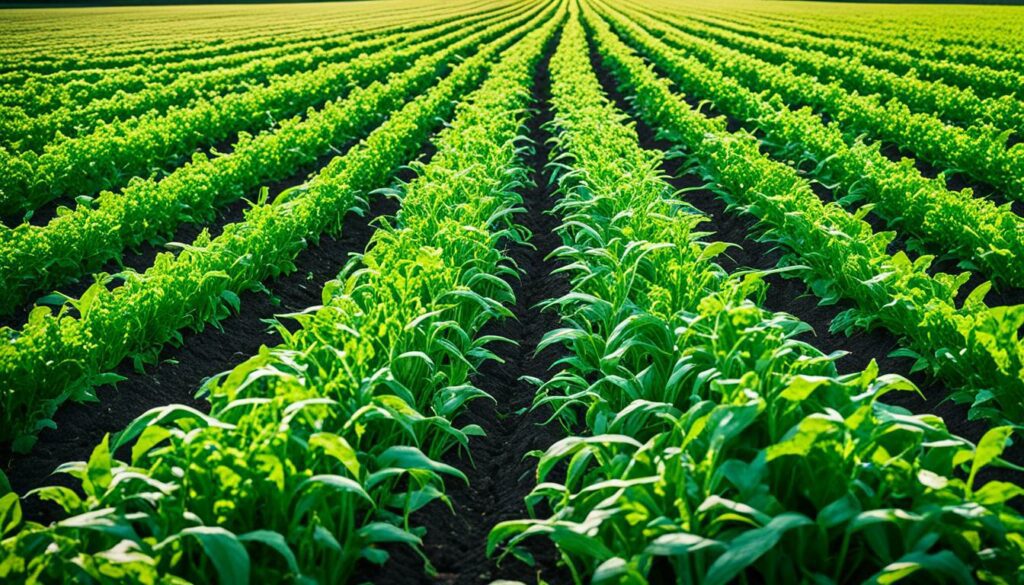
For summer crops to grow well, managing water is key. Drip irrigation helps stop plants from getting too dry without wasting water. Cover crops are also very important. They hold moisture in the soil, stop erosion, and cut down on nutrient loss. This improves the soil and helps crops grow better.
Smart farming is all about creating the best conditions for crops. This includes dealing with heat, water, and adding the right plant food. Cover crops can really help by making the soil healthier. It’s best to start small by trying different cover crops to see what works best.
Here is a comparison of the benefits of cover crops for summer crop resilience:
| Benefit | Description |
|---|---|
| Increased Crop Yields | Stabilised production and profitability. |
| Enhanced Soil Fertility | Improved soil organic matter and nutrient capture post-harvest. |
| Pest Suppression | Reduced soil compaction and pest issues. |
| Water Pollution Prevention | Reduced runoff and CO2 removal. |
| Economic Benefits | Reduced costs, enhanced yields, and support for beneficial organisms and pollinators. |
By using these methods and always finding new ways to improve, we can make summer crops stronger against the changing climate.
The China’s Maize Belt is critical in studying climate change’s impact on crops. It looks at how soil properties and simulation models help understand these changes. This knowledge influences farming and food availability.
The APSIM tool plays a key role. It helps see how climate changes affect maize growth. Its advanced features allow for different climate modelling. This lets us study how soil affects maize in varying climates.
Across twenty-nine provinces, maize fields react differently to climate changes. Using data from 1981 to 2018, it found big variations in rainfall and temperature’s effects. Some places saw major drops in maize. Others improved by adjusting when and how they plant. This shows the need for flexible, area-specific farming methods.
Soil types and quality greatly affect maize’s ability to withstand climate changes. The amount of soil carbon, its texture, and how well it holds water are key. Places with richer soil did better under pressure. The right soil can help keep yields stable during rough times. So, good soil care is key for farming success.
These outcomes highlight the deep link between climate shifts, local farm responses, and soil. APSIM’s use helps find strategies to make farming more resilient. Its insights are vital for securing food in uncertain climates.
Agriculture is always changing and needs new *technological innovations* for *sustainable farming*. An example is the workshop in Wageningen in July 2000. There, nations talked about using new technology. They also tested these ideas on experimental farms to see if they work well.
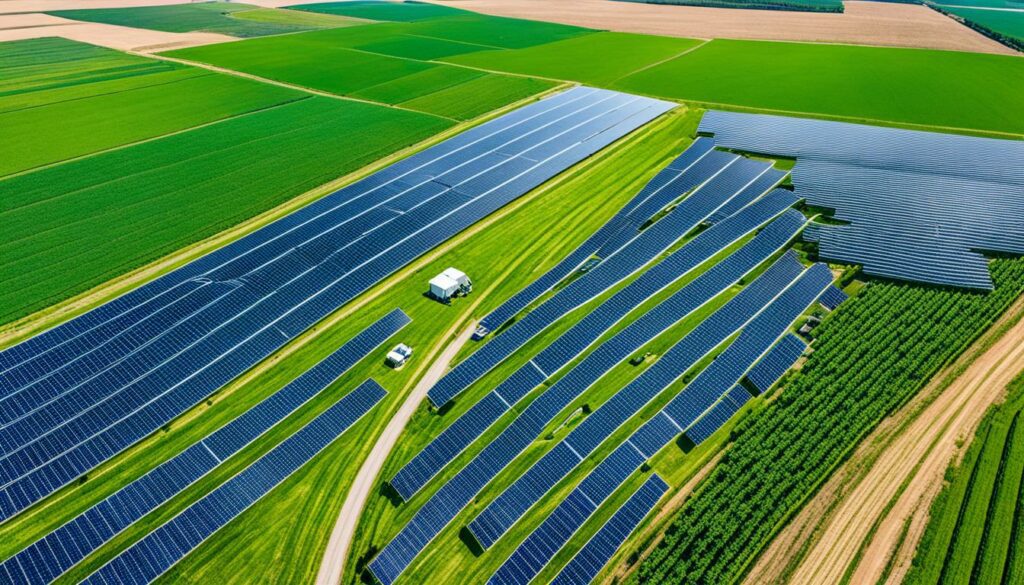
*Advanced biotechnology* is key for more resilient and productive crops. Places like California show how organic farming can benefit from using biology to improve growth. This approach helps crops withstand the challenges of climate change.
*Big data* and *predictive analytics* help farmers choose what to do by looking at weather and soil. Countries like Canada and Switzerland find these tools very important. They help in traditional agriculture, where there’s a focus on diversity and using nutrients well.
*Automation* and *smart farming* are changing how we farm. Technology like precision agriculture is making farming smarter. It’s improving how we use water, fight pests, and look after the land.
Climate shifts really affect agriculture, putting farmers under severe pressure. Drought hurts crops a lot, especially when it’s hot. If these two hit at the same time, crop losses can soar to 40%. This has led to drops in corn and soy yields by 5%, messing with our food chain.
In the U.S., corn farming is set to drop, particularly in Missouri, Kansas, and the Carolinas. However, places like Nebraska, Iowa, and Illinois will see the biggest hit. Soy farming is pretty much the same story, with bad times ahead for Oklahoma and Kansas. The effects will spread, severely worrying about agricultural economics in the Missouri and Mississippi River Valleys.
Historical data shows that drought and extreme heat from 1970 to 2013 made crops very sensitive to heat. Sadly, the future doesn’t look brighter. Climate models predict drops of up to 7% for corn and 9% for soybeans after 2050. This is as drought and heat link up in more places.
In the Midwest and Great Plains, drought might make things 10 to 20% worse for crops. This poses a big threat, making these areas very vulnerable. Farmers here are already facing big losses due to unpredictable weather, damaging their incomes.
Together with researchers, studies are showing us the financial hit from changes in corn and soy farm outputs. This puts the spotlight on the significant impacts of climate shifts. It makes it clear we need smart planning to keep our food supply chain tough.
“Warmer temperatures project increased energy requirements to maintain healthy livestock and greater proliferation of parasites and disease pathogens. The more vulnerable our crops and livestock become, the more precarious the economic landscape for agriculture turns.”
Washington stands out for its big variety of crops – over 300 are grown there. Agriculture makes up 12% of the state’s economy. Even with about 15 million acres of farmland, the industry is at risk from climate changes. The future for crops like winter wheat, spring wheat, and wine grapes isn’t looking great.
Climate models stress the need for quick action. They also point to the risk of new pests in farms because of the warmer weather. This highlights the multiple dangers climate shifts bring. It also shows how agricultural economics and food security are tied up worldwide.
With more intense and frequent climate challenges on the horizon, it’s crucial to strengthen crop resilience. In the Northeastern United States, heavy rains lead to soil erosion and nutrient loss. Besides, wet weather during spring and autumn makes it harder to work in the fields. In this changing climate, it’s vital to adapt.
Cover crops are a key part of making fields more resilient. They boost the amount of organic matter in the soil. This makes the soil hold onto moisture better. Cover crops also stop soil from washing away and keep important nutrients in place. When they break down, they add to the soil’s richness and structure.
In the short term, using cover crops can be costly. You need money for seeds, fuel, and planting. But in the long run, they help you save on growing costs. They also lead to better harvests. Plus, they reduce the need for lots of machinery, and they can help control weed and pest problems.
Another crucial step is crop rotation. Trials in China saw huge growth in the use of this method over five years. Despite some economic setbacks from bad weather, studies underscore its water-saving benefits. Experts show that rotating crops can use water more efficiently. This reduces the water the soil needs and helps it retain rainwater better.
Reflecting on crop resilience’s future, we see the need for a mix of strategies. The USDA has listed 13 ways to improve resilience. There’s also wide insurance coverage for farmers. This shows a strong national commitment to keeping farms stable. By applying these measures, we can prepare for climate changes. This can lead to stronger, more sustainable farming in the future.
Crop wild relatives are key in boosting genetic diversity. They bring in useful traits like the ability to survive droughts and high temperatures. The Crop Trust works with groups such as Embrapa to find these wild plants. They are then used to improve the strength of important crops.
Changes in the weather, like rain and sunshine patterns, can really hurt how much crops grow. Maize, for example, can suffer a lot from these changes. In parts of China, shifts in the climate can either help or harm maize production.
In pre-breeding for climate change, we first identify helpful traits from wild plants. Then, we put these traits into breeding programmes. This helps create crops that can handle tough weather. Projects like the Crop Wild Relatives initiative show us how.
Trials in places like Brazil and India have proven that plants that can survive droughts really work. In India, dry spells have badly reduced wheat harvests. This underlines the worldwide demand for crops that can resist droughts.
Small farmers play a big role in making crops stronger against climate change. They test crops locally and work with scientists. This has helped in making crops in places like China and Kazakhstan better at handling climate shifts.
Having small farmers test new crops is crucial. They know their land best and work closely with experts. This ensures new crops can really survive in local conditions, like what’s seen with eggplant in Taiwan.
Soil health, like how much organic matter is in it, affects how well crops cope with change. Good soil gives plants the best nutrients and helps them deal with bad weather. This means better harvests even when the weather is rough.
New farming techniques, such as better ways to use water, tough plants, and recycling water, are vital for handling climate change. They keep the farms productive and help farmers and the environment in the long run.
Working together across borders is a big plus in making crops stronger. Research groups, think tanks, and funds all pitch in. Projects like the Crop Wild Relatives effort are great examples of what these partnerships can achieve.
For summer crops to do well, we focus on making them better at handling heat, good with water, and creating the right growing conditions. These steps help reduce the harm from hotter summers and changing weather.
The APSIM model helps us see how climate changes affect crops, like maize in China. It points to the need for plans customised to each area’s climate situation. This way, we can prepare better for future weather changes.
Modern technology, including biotech, data analysis, and clever farming methods, is key for a green future. These tools help us fight the effects of the changing climate and make farming more durable.
Changes in the weather can shake up how well farms do and the foods we have. Droughts, like in India and Europe, show why resilient crops are so important. They help keep food supplies steady and economies strong.
In the future, we will focus on making crops better at adapting, especially to droughts. We will use smart farming that helps us deal with weather changes. Working ahead and staying creative are the keys to protecting our crops.